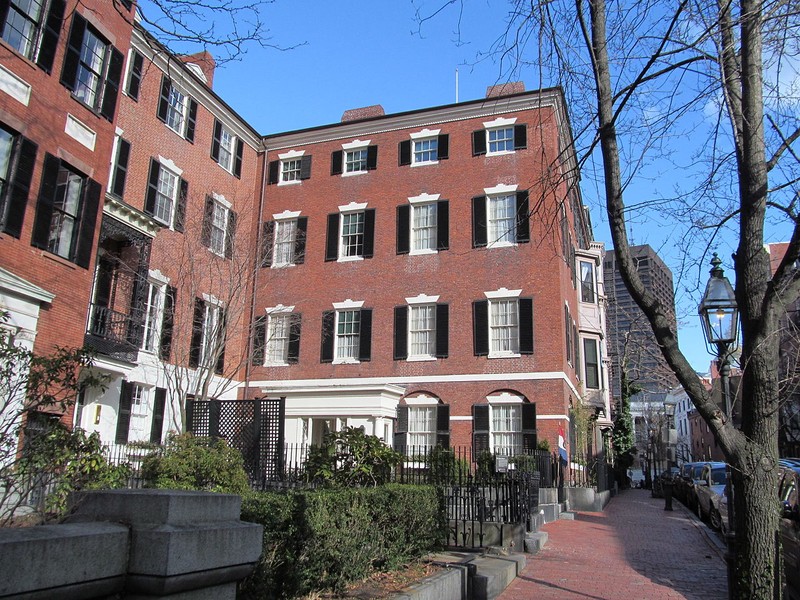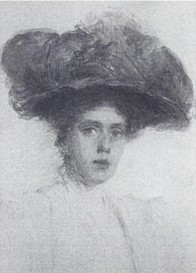Nichols House Museum
Introduction
Text-to-speech Audio
The Nichols House Museum serves to educate visitors about the lives of women during the 19th and early 20th centuries and the history of the Beacon Hill district of Boston. Located in a townhouse that was built in the early 1800s and was home to Rose Standish Nichols from 1885 until 1960. Rose Standish Nichols was a suffragist and pacifist, as well as an accomplished landscape architect. The museum is open year round and offers an abundance of lectures, programs, special events, and tours.
Images

A watercolor portrait of Rose Standish Nichols c. 1912

Backstory and Context
Text-to-speech Audio
The museum resides within the 4-story townhouse that Rose Nichols inherited from her father, Dr. Arthur Nichols. The historic house was built by Jonathan Mason in 1804 and became a public museum in 1961. The home is furnished with 18th and 19th century European and American furniture, ancestral portraits, American and European art, and Flemish tapestries. Highlights of the museum include exhibits about the life of Rose Standish Nichols, her father Dr. Arthur Nichols, and other prominent residents of this important Boston neighborhood. Visitors should also take time to enjoy works by Augustus Saint-Gaudens, America's foremost sculptor of the 19th century. Many of the sculptures to leading generals were made by Augustus Saint-Gaudens, including the popular local sculpture of Robert Gould Shaw that graces Boston Common.
Rose Standish Nichols was born in 1872 and resided in the Nichols House from age thirteen until her death in 1960. During her lifetime, she became known for her work involving gardens. Her interest in gardening began when she was a child and her grandfather Thomas Johnston Homer "allowed her to cultivate a small corner of his garden in Roxbury." Rose's horticultural education continued in 1899 when her family visited a Cornish Colony in New Hampshire. Rose convinced her parents to buy a farmhouse in Cornish where she spent her summers learning about gardening. In Cornish, Rose tutored with an artist and architect Charles A. Platt. She also studied drafting in New York one Winter with Thomas Hastings who had an architectural firm called Carrere and Hastings. Rose went on to study at the Massachusetts Institute of Technology and in Paris. Although Rose is remembered as a landscape architect, she considered herself a writer and connoisseur rather than a designer. She wrote three books (English Pleasure Gardens, Spanish and Portuguese Gardens, and Italian Gardens and Villas) about historical gardens in England, Italy, and Spain. Rose's writing included several articles about historical gardens as well.
Aside from being an accomplished writer, Rose became one of the earliest professional garden designers in the United States. Her first garden was at the family's house in Cornish. She went on to receive several commissions from across the United States. Her first professional commission was from her neighbor in Beacon Hill, Ellen Mason, who wanted help with her garden in Newport, Rhode Island. Rose's commissions from within New England included a few well-known Bostonians such as Mrs. Francis Peabody and Mrs. Philip Sears. Few of the gardens she designed have survived and have not been restored due to a lack of surviving plans, drawings, and correspondence with clients. After Rose died, the Nichols House became a museum at her request. The Nichols House Museum honors Rose Standish Nichols' life and legacy while also providing insight into the life of Beacon Hill residents during the 19th and 20th centuries.
Cite This Entry
Herndon, Sarah. "Nichols House Museum." Clio: Your Guide to History. November 22, 2022. Accessed April 11, 2025. https://theclio.com/entry/14960
Sources
About the Museum, Nichols House Museum. Accessed November 22nd, 2022. https://www.nicholshousemuseum.org/about/.
Tankard, Judith B.. Rose Standish Nichols, a Proper Bostonian, Nichols House Museum. Accessed November 22nd, 2022. https://www.nicholshousemuseum.org/wp-content/uploads/2020/04/Tankard_A-Proper-Bostonian.pdf.
Rose Standish Nichols (1872-1960), Nichols House Museum. Accessed November 22nd, 2022. https://www.nicholshousemuseum.org/rose-standish-nichols/.
Nichols House Museum

